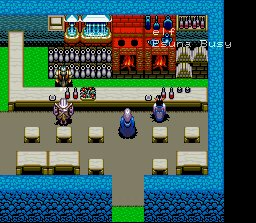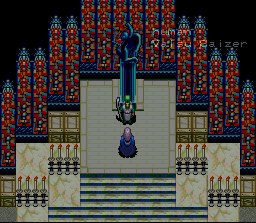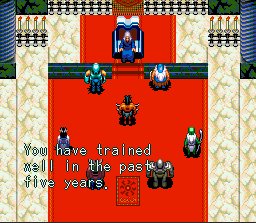
 |
|
Most gamers who've played 7th Saga in its heyday often remember it as the mediocre title overshadowed by Square's fan-favorite, Secret of Mana. On the other hand, 7th Saga has its fierce defenders who often argue that its affirmative characteristics have been disregarded. As one of the most contentious titles to be released for the SNES, and indeed vaulted by the GIA; we present two sides of the heated debate: a retrospective and counterpoint. If Enix is known for one thing, it's adherence to tradition. With scant few exceptions, Enix games simply aren't known as innovative. That said, there are few companies capable of pulling more mileage from a successful formula than Enix. What their titles lack in pioneering spirit, they historically make up for in solid execution.
For the majority of the game, 7th Saga is a relatively simple "find the treasure, save the world" adventure. As the game begins, players find themselves in an audience with King Lemele, along with six other apprentices. The seven have spent the last five years training for the quest about to unfold. Lemele charges the seven adventurers with acquiring the seven fabled artifacts called the Runes, explaining that the one who lays hands on all seven will become the new ruler of Ticondera. The apprentices each have unique loyalties and beliefs, and different plans for the Runes after obtaining the entire collection. Thus, the quest begins. 7th Saga may be an uneven game with as many weaknesses as strengths, but most critics unfairly overlook its positive aspects. Make no mistake--7th Saga is anemic in many of the aspects that make a successful mainstream RPG, and it's far from perfect. However, these flaws don't leave this RPG devoid of redeeming value. The game's most well known turn-offs lie primarily in three areas: sound, difficulty, and twisting plot. And in today's RPG market, the leisurely pace and lack of obvious hooks explain its limited success against more fast-paced, attention-grabbing games. Even at the time of its release, 7th Saga's benchmark competition was Square's Final Fantasy II, whose sound and plot far surpassed those of Enix's game. 7th Saga employs a painfully thin variety of synthetic instrument patches, and the composition itself leaves much to be desired. Tunes with more than three or four tracks are rare, and the entire game's soundtrack could easily fit on one side of a 90-minute cassette.
Though the story at first seems like another weakness, it lays out its admittedly unimaginative plot points quite solidly. Several of the game's seven Runes can be earned in any order the player likes. Similar to Dragon Warrior II & III, the storyline alternates linear exposition with nonlinear exploration. Seen in this light, the ostensibly weak plot is a necessary side effect of the game's nonlinear design. The framing story does its job of holding the game together, but the meat of the plot takes place in a series of mini-quests, each centered around obtaining one of the Runes. The greatest strength of 7th Saga's plot lies without a doubt in the game's party dynamics. Since all seven apprentices are questing after the same set of treasures, it only makes sense that they would occasionally bump into one another. The results can vary widely when you approach another apprentice, depending on your character's alignment, strength, past dealings, and even number of Runes in hand. Your meeting may result in a permanent alliance, a deferral, or even an outright assault -- one of the least desirable circumstances of the game. All six of your rivals gain experience at the same rate as your character, so it's futile to try and build experience to overpower the apprentices. Even worse, any Runes you've obtained will be forfeited to your rival if you lose.
Though 7th Saga largely restricts itself to polishing established ideas, it does bring a new concept or two to the table, many of which were inexplicably never seen again. At the outset of the quest, King Lemele grants each of the seven apprentices a Crystal Ball to help them identify the Runes. This Crystal was one of the best ideas to hit the genre in a long time, and similar devices would be welcome even in some of today's RPGs. The concept is simple: on the field map and in dungeons, a radarlike circle in the upper left corner displays the location of monsters, treasure chests, towns, caves, and even Runes. Another useful addition, the gem system, acts as an insurance policy against monster attacks. Before leaving on a journey, money can be traded at item shops for gems. If disaster strikes and monsters defeat your party, they steal half your cash reserves. Precious gems, however, are left intact. Then, upon arrival at your destination, gems can be resold for their entire purchase price. Gamers who pick 7th Saga up should be prepared: it is difficult, and requires many hours spent building levels the old-fashioned way. It's most definitely not for the weak of heart, or the casual RPG fan. It doesn't shower players with rewards for every tiny accomplishment as many present-day RPG's do, but those with the constitution to slug it out may find more to get excited about than the game's vocal critics would lead them to believe. Retrospective by Bill Johnson, freelance. Counterpoint7th Saga is a deeply, deeply flawed and intensely dull game, far below the standards of RPGs of its era. It is often held up as a paragon of mediocrity, of a game that is long but dull, with breadth but little depth. Perhaps the most glaring aspect of the game is the characterization. Or rather, the lack thereof. The game features seven main characters. They run the gamut, everything from a demon to a priest. And yet, for all this, the only time they evidence any sort of personality is right at the start, in the meeting room before the adventure begins. They otherwise undertake an almost identical quest, with only Olvan and LUX boasting any differentiation along the way. When you meet them along the way, the obvious conflicts between characters (demonic Lejes and priestly Valsu probably shouldn't be getting along) aren't reflected substantially in the text. The dialogue spoken by Lejes as he rejects LUX the robot's offer of companionship is essentially the same as he gives to Valsu. The theory is that opposing characters will be less liable, gameplay mechanic-wise, to offer to join you, but it's seldom reflected in play - in four times through the game, I have never been unable to form any team of characters, and have been attacked by other characters only once.
The result is a game where you get the distinct sensation that you might as well be an especially battle-worthy monkey. The plot twists are always the same - in one playthrough, I was amused to discover that the 'good' bishop Valsu had forcibly taken over a town. Your choices throughout the game, whatever order you make them in thanks to the somewhat non-linear nature of the story, are completely irrelevant. What's the point of 'role-playing' if neither you nor the game itself has any capacity to infuse choice into the title? 7th Saga is more linear and constrained than a Gradius game. You are playing a role only insofar as you are choosing which weapons and armor to equip as you progress. Now, all of this would be a lot more tolerable if the game had really diverse and deep gameplay. Or, better yet, exceptional visual and aural candy for you. It has neither. The graphics are plain at best, perhaps most notable for the Phantasy Star-esque battle sequences and animated enemies. The sound is actively terrible, with the often-heard battle theme beginning with a high pitched shrieking sound that's apparently supposed to be music. The town and dungeon music is forgettable, and loops within twenty seconds or so. The translation is serviceable but unexceptional. Again, characters don't evidence any personality through their dialogue. Concepts like dialect are a long way off. Still, much about the game is forgiven in light of its most impressive bit of nonsensical text. During the game, you meet a bounty hunter named Pison. After defeating him the first time, he reappears later in the game, and when spoken to, he proudly announces "I've returned from the Dark World and have become Red-Pison." And attacks you. How did he come back to life? Why did this turn him bright red? In a literal sense, it's just fine - there's nothing grammatically wrong with his statement. But it just doesn't make any sense, fundamentally.
The gameplay is less impressive. The degree to which you can customize your characters is essentially nil; don't be expecting a choice of skills, or carefully selecting equipment to improve your speed. If you see equipment that is more expensive than what you are currently using, it's better. There are no optional sidequests, no mini-games, no hidden secrets, and one lonely non-plot-related dungeon to discover. Therefore, you'll be spending a lot of time walking around the overworld and dungeons, and fighting monsters. A lot of them. The Crystal Ball display in the corner of your screen usually proves to be useless, since monsters tend to be faster than you are, and aren't encumbered by such details as walls, or other solid objects. While you're running through twisting passageways, you watch the crystal ball in horror as swarms of enemies race towards your position at terrific speeds, apparently passing through any obstacle in their paths. All of which brings us to the fine tradition of sitting on your butt and whacking monsters to gain levels for hours. And hours. And hours. 7th Saga is not difficult, per se. There is nothing challenging about hitting the Fight command for six hours until your levels rise high enough to progress comfortably through the next dungeon. Gaining levels doesn't help you in a handful of battles, against the other main characters, but it's essential for the remaining 95% of the game. Now, if this is your idea of 'fun', you're gonna love 7th Saga. This is the heart of the game. If you like building your levels, you'll love the game. If not, you'll hate it, because it has nothing else to offer you. Enix is best known for its seminal Dragon Quest/Warrior series, often cited as the epitome of 'old school' RPGing. DQ games boast lengthy quests, massive dungeons, mini games galore, subquests, increasingly diverse tactical options, and in the later (IV and onwards) installments, characters who react and respond to the world around them. 7th Saga is nothing compared to Dragon Quest. It emulates the basic concepts - level-building and dungeon crawling - without breadth or diversity. It does not innovate. It does not enthrall. It's the antithesis of a role-playing game. Whether you choose Valsu or Kamil, LUX or Lejes, you will have the same experience. It's a Player Optional Game. Counterpoint by Allan Milligan, Lapsed Agent. |
|
||||||||||||||||||||||||||||||||||||||||||||||





